Page 318 of 416
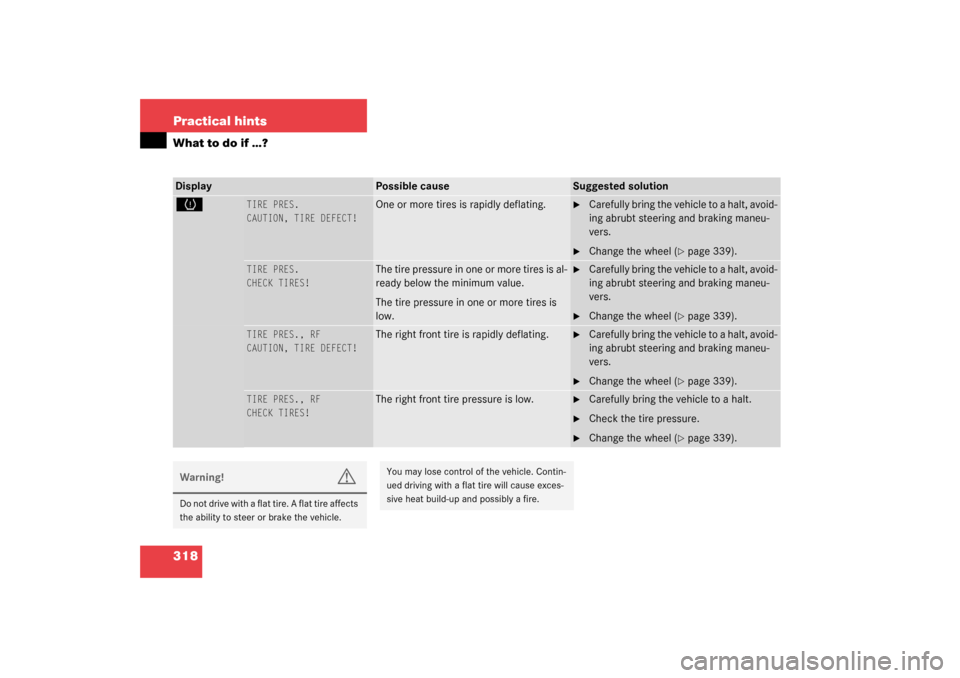
318 Practical hintsWhat to do if …?Display
Possible cause
Suggested solution
H
TIRE PRES.
CAUTION, TIRE DEFECT!
One or more tires is rapidly deflating.
�
Carefully bring the vehicle to a halt, avoid-
ing abrubt steering and braking maneu-
vers.
�
Change the wheel (
�page 339).
TIRE PRES.
CHECK TIRES!
The tire pressure in one or more tires is al-
ready below the minimum value.
The tire pressure in one or more tires is
low.
�
Carefully bring the vehicle to a halt, avoid-
ing abrubt steering and braking maneu-
vers.
�
Change the wheel (
�page 339).
TIRE PRES., RF
CAUTION, TIRE DEFECT!
The right front tire is rapidly deflating.
�
Carefully bring the vehicle to a halt, avoid-
ing abrubt steering and braking maneu-
vers.
�
Change the wheel (
�page 339).
TIRE PRES., RF
CHECK TIRES!
The right front tire pressure is low.
�
Carefully bring the vehicle to a halt.
�
Check the tire pressure.
�
Change the wheel (
�page 339).
Warning!
G
Do not drive with a flat tire. A flat tire affects
the ability to steer or brake the vehicle.
You may lose control of the vehicle. Contin-
ued driving with a flat tire will cause exces-
sive heat build-up and possibly a fire.
Page 319 of 416

319 Practical hints
What to do if …?
Display
Possible cause
Suggested solution
H
TIRE PRES., LF
CAUTION, TIRE DEFECT!
The left front tire is rapidly deflating.
�
Carefully bring the vehicle to a halt, avoid-
ing abrupt steering and braking maneu-
vers.
�
Change the wheel (
�page 339).
TIRE PRES., LF
CHECK TIRES!
The left front tire pressure is low.
�
Carefully bring the vehicle to a halt.
�
Check the tire pressure.
�
Change the wheel (
�page 339).
TIRE PRES., RR
CAUTION, TIRE DEFECT!
The right rear tire is rapidly deflating.
�
Carefully bring the vehicle to a halt, avoid-
ing abrubt steering and braking maneu-
vers.
�
Change the wheel (
�page 339).
TIRE PRES., RR
CHECK TIRES!
The right rear tire pressure is low.
�
Carefully bring the vehicle to a halt.
�
Check the tire pressure.
�
Change the wheel (
�page 339).
Warning!
G
Do not drive with a flat tire. A flat tire affects
the ability to steer or brake the vehicle.
You may lose control of the vehicle. Contin-
ued driving with a flat tire will cause exces-
sive heat build-up and possibly a fire.
Page 320 of 416
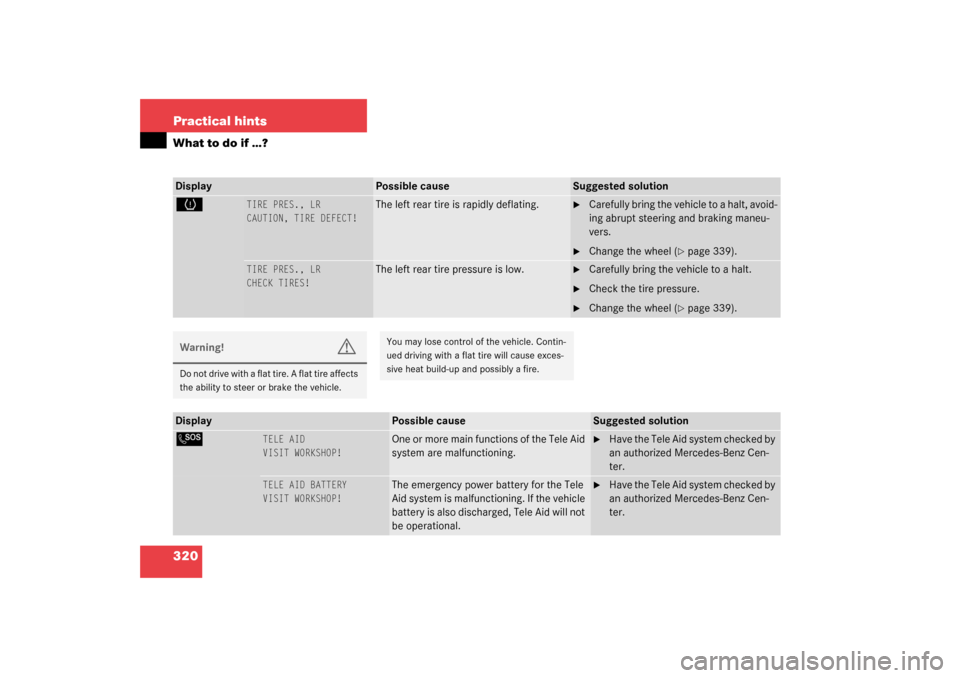
320 Practical hintsWhat to do if …?Display
Possible cause
Suggested solution
H
TIRE PRES., LR
CAUTION, TIRE DEFECT!
The left rear tire is rapidly deflating.
�
Carefully bring the vehicle to a halt, avoid-
ing abrupt steering and braking maneu-
vers.
�
Change the wheel (
�page 339).
TIRE PRES., LR
CHECK TIRES!
The left rear tire pressure is low.
�
Carefully bring the vehicle to a halt.
�
Check the tire pressure.
�
Change the wheel (
�page 339).
Warning!
G
Do not drive with a flat tire. A flat tire affects
the ability to steer or brake the vehicle.
You may lose control of the vehicle. Contin-
ued driving with a flat tire will cause exces-
sive heat build-up and possibly a fire.
Display
Possible cause
Suggested solution
L
TELE AID
VISIT WORKSHOP!
One or more main functions of the Tele Aid
system are malfunctioning.
�
Have the Tele Aid system checked by
an authorized Mercedes-Benz Cen-
ter.
TELE AID BATTERY
VISIT WORKSHOP!
The emergency power battery for the Tele
Aid system is malfunctioning. If the vehicle
battery is also discharged, Tele Aid will not
be operational.
�
Have the Tele Aid system checked by
an authorized Mercedes-Benz Cen-
ter.
Page 325 of 416
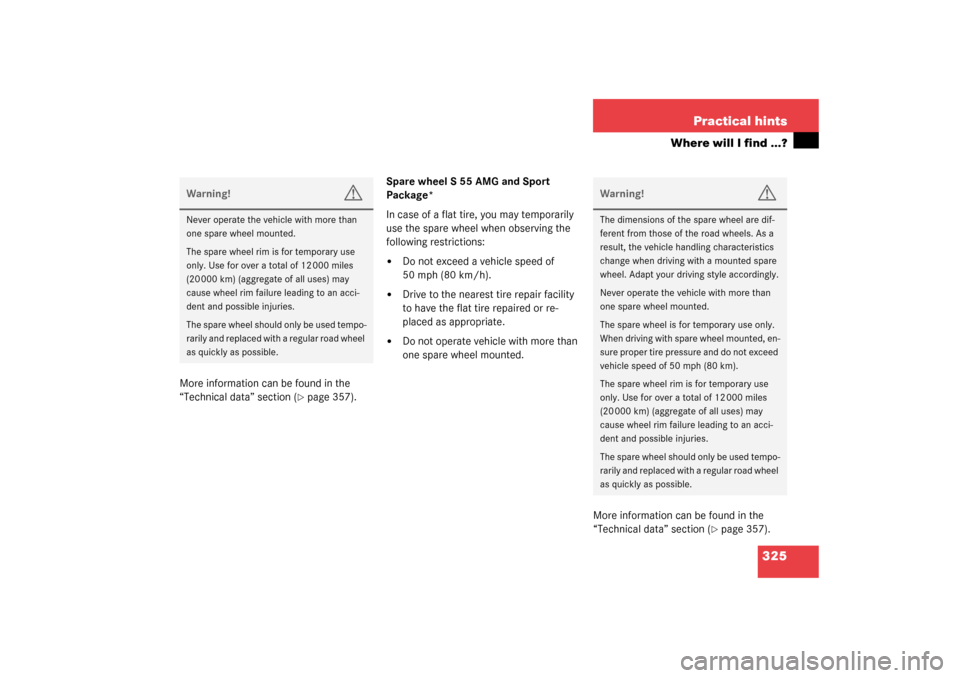
325 Practical hints
Where will I find ...?
More information can be found in the
“Technical data” section (
�page 357).Spare wheel S 55 AMG and Sport
Package*
In case of a flat tire, you may temporarily
use the spare wheel when observing the
following restrictions:
�
Do not exceed a vehicle speed of
50 mph (80 km/h).
�
Drive to the nearest tire repair facility
to have the flat tire repaired or re-
placed as appropriate.
�
Do not operate vehicle with more than
one spare wheel mounted.
More information can be found in the
“Technical data” section (
�page 357).
Warning!
G
Never operate the vehicle with more than
one spare wheel mounted.
The spare wheel rim is for temporary use
only. Use for over a total of 12 000 miles
(20 000 km) (aggregate of all uses) may
cause wheel rim failure leading to an acci-
dent and possible injuries.
The spare wheel should only be used tempo-
rarily and replaced with a regular road wheel
as quickly as possible.
Warning!
G
The dimensions of the spare wheel are dif-
ferent from those of the road wheels. As a
result, the vehicle handling characteristics
change when driving with a mounted spare
wheel. Adapt your driving style accordingly.
Never operate the vehicle with more than
one spare wheel mounted.
The spare wheel is for temporary use only.
When driving with spare wheel mounted, en-
sure proper tire pressure and do not exceed
vehicle speed of 50 mph (80 km).
The spare wheel rim is for temporary use
only. Use for over a total of 12 000 miles
(20 000 km) (aggregate of all uses) may
cause wheel rim failure leading to an acci-
dent and possible injuries.
The spare wheel should only be used tempo-
rarily and replaced with a regular road wheel
as quickly as possible.
Page 339 of 416
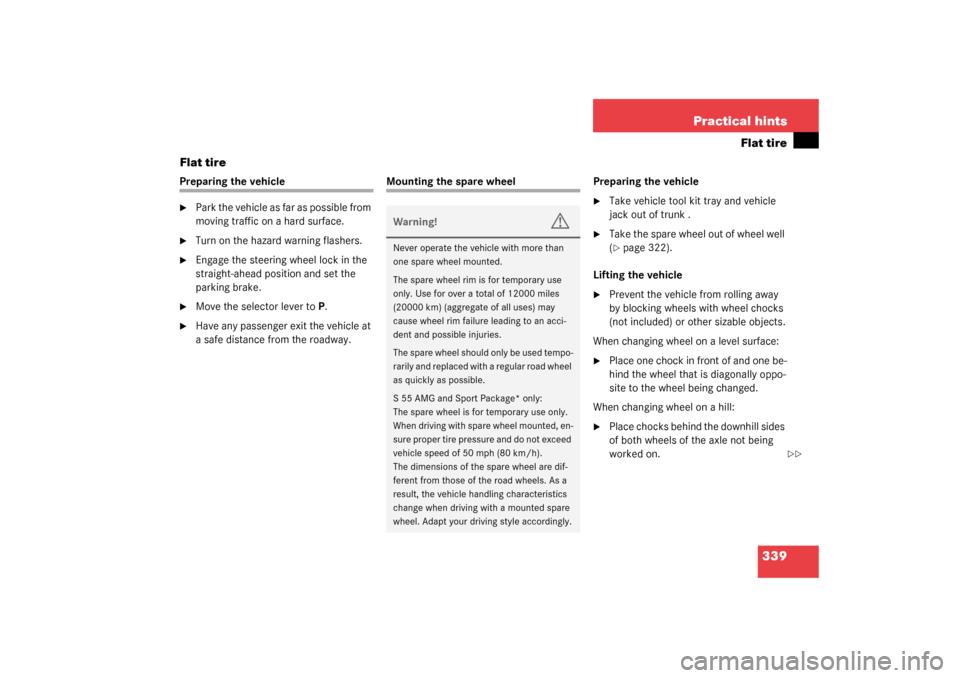
339 Practical hints
Flat tire
Flat tire
Preparing the vehicle�
Park the vehicle as far as possible from
moving traffic on a hard surface.
�
Turn on the hazard warning flashers.
�
Engage the steering wheel lock in the
straight-ahead position and set the
parking brake.
�
Move the selector lever toP.
�
Have any passenger exit the vehicle at
a safe distance from the roadway.
Mounting the spare wheel Preparing the vehicle
�
Take vehicle tool kit tray and vehicle
jack out of trunk .
�
Take the spare wheel out of wheel well
(�page 322).
Lifting the vehicle
�
Prevent the vehicle from rolling away
by blocking wheels with wheel chocks
(not included) or other sizable objects.
When changing wheel on a level surface:
�
Place one chock in front of and one be-
hind the wheel that is diagonally oppo-
site to the wheel being changed.
When changing wheel on a hill:
�
Place chocks behind the downhill sides
of both wheels of the axle not being
worked on.
Warning!
G
Never operate the vehicle with more than
one spare wheel mounted.
The spare wheel rim is for temporary use
only. Use for over a total of 12000 miles
(20000 km) (aggregate of all uses) may
cause wheel rim failure leading to an acci-
dent and possible injuries.
The spare wheel should only be used tempo-
rarily and replaced with a regular road wheel
as quickly as possible.
S 55 AMG and Sport Package* only:
The spare wheel is for temporary use only.
When driving with spare wheel mounted, en-
sure proper tire pressure and do not exceed
vehicle speed of 50 mph (80 km/h).
The dimensions of the spare wheel are dif-
ferent from those of the road wheels. As a
result, the vehicle handling characteristics
change when driving with a mounted spare
wheel. Adapt your driving style accordingly.
��
Page 343 of 416
343 Practical hints
Flat tire
�
Before storing the jack in the trunk, it
should be fully collapsed, with handle
folded in.
�
Place the wheel bolt wrench, alignment
bolt and jack back in the vehicle tool kit
in the trunk and close the covering lid.
Replacing jack support tube cover
�
Slide tongue of cover under the upper
edge of the tube opening.
�
Applying even pressure, press cover
until it snaps into place. Be careful not
to damage the locking tabs or clamp
the plastic retaining strap.!You can also screw the faulty wheel
down into the spare wheel well in the
trunk.
Do not activate the tire inflation pres-
sure monitor until the depressurized
tire is no longer in the vehicle.
��
Page 364 of 416
364 Technical dataRims and tires
Rims and tiresUse only tires and rims which have been
specifically developed for your vehicle and
tested and approved by Mercedes-Benz.
Other tires and rims can have detrimental
effects, such as:�
Poor handling characteristics
�
Increased noise
�
Increased fuel consumption
!Moreover, tires and rims not approved
by Mercedes-Benz may, under load, ex-
hibit dimensional variations and differ-
ent tire deformation characteristics
that could cause them to come into
contact with the vehicle body or axle
parts. Damage to the tires or the vehi-
cle can be the result.
iFurther information on tires and rims is
available at any authorized
Mercedes-Benz Center. A tire inflation
pressure table is located on the fuel fill-
er cap of the vehicle. The tire pressure
should be checked regularly and
should only be adjusted on cold tires.
Follow tire manufacturer’s mainte-
nance recommendation included with
vehicle.
Page 388 of 416
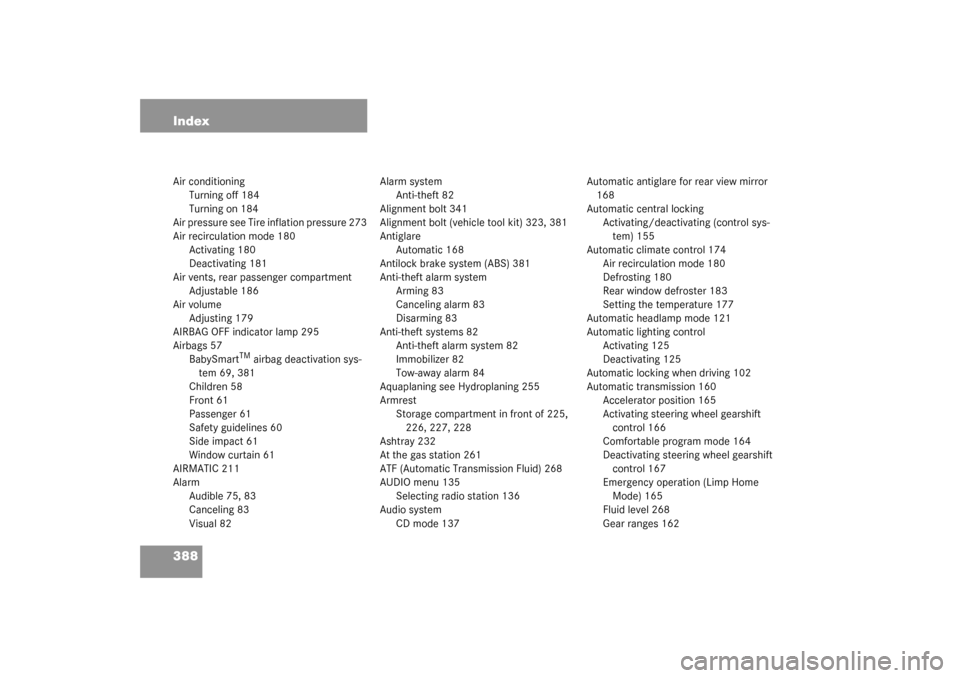
388 IndexAir conditioning
Turning off 184
Turning on 184
Air pressure see Tire inflation pressure 273
Air recirculation mode 180
Activating 180
Deactivating 181
Air vents, rear passenger compartment
Adjustable 186
Air volume
Adjusting 179
AIRBAG OFF indicator lamp 295
Airbags 57
BabySmart
TM airbag deactivation sys-
tem 69, 381
Children 58
Front 61
Passenger 61
Safety guidelines 60
Side impact 61
Window curtain 61
AIRMATIC 211
Alarm
Audible 75, 83
Canceling 83
Visual 82Alarm system
Anti-theft 82
Alignment bolt 341
Alignment bolt (vehicle tool kit) 323, 381
Antiglare
Automatic 168
Antilock brake system (ABS) 381
Anti-theft alarm system
Arming 83
Canceling alarm 83
Disarming 83
Anti-theft systems 82
Anti-theft alarm system 82
Immobilizer 82
Tow-away alarm 84
Aquaplaning see Hydroplaning 255
Armrest
Storage compartment in front of 225,
226, 227, 228
Ashtray 232
At the gas station 261
ATF (Automatic Transmission Fluid) 268
AUDIO menu 135
Selecting radio station 136
Audio system
CD mode 137Automatic antiglare for rear view mirror
168
Automatic central locking
Activating/deactivating (control sys-
tem) 155
Automatic climate control 174
Air recirculation mode 180
Defrosting 180
Rear window defroster 183
Setting the temperature 177
Automatic headlamp mode 121
Automatic lighting control
Activating 125
Deactivating 125
Automatic locking when driving 102
Automatic transmission 160
Accelerator position 165
Activating steering wheel gearshift
control 166
Comfortable program mode 164
Deactivating steering wheel gearshift
control 167
Emergency operation (Limp Home
Mode) 165
Fluid level 268
Gear ranges 162